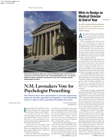In the wake of the traumatic events of September 11, pharmaceutical companies drastically increased their expenditures for television advertising of antidepressants and prescription sleep aids. The increased advertising came at the same time as a new head-to-head comparison of the top three SSRI antidepressants raised serious questions about the grounds on which the drugs’ manufacturers rest their marketing assertions (see story on
page 25).
According to data compiled by Nielsen Media Research, the independent media research company best known for its television ratings, pharmaceutical commercials increased dramatically in the weeks after September 11.
GlaxoSmithKline, maker of Paxil (paroxetine)—generally considered to be the market sales leader among SSRIs—spent a whopping $16.5 million on television ads promoting the drug during the month of October of last year, nearly twice as much as it did during the same month in 2000.
Pfizer, the world’s largest pharmaceutical company, spent $5.6 million promoting the benefits of Zoloft (sertraline) in treating posttraumatic stress disorder during October 2001. In October 2000 the company didn’t buy any commercial airtime for its highly competitive product.
Depending upon how you look at the data, both GlaxoSmithKline and Pfizer can claim the “best selling” label for its antidepressant. If you consider total dollar sales figures, Zoloft wins the competition; however, if you look at the number of actual prescriptions dispensed during a given time period, Paxil usually edges Zoloft by a thin margin. Paxil usually sells at a slightly lower price, however, so its higher number of prescriptions dispensed actually ring up fewer dollars in the total-sales column.
The current number-three selling antidepressant, Eli Lilly and Company’s Prozac (fluoxetine), has been struggling to keep market share after relinquishing the top spot (both in sales dollars and number of prescriptions dispensed) last fall when it lost market exclusivity to generic competition.
To bolster sales after the events of September 11, Lilly spent just over $2 million on television ads during October 2001. Comparative figures for Lilly’s promotion of Prozac and Prozac Weekly during October 2000 were not available.
Sleep Medications
Companies manufacturing medications to promote sleep also increased their advertising spending after September 11. The leading prescription sleeping aid, Ambien (zolpidem), made by G.D. Searle and Co., was heavily advertised in the weeks after the terrorist attacks. The company spent just under $5 million on television ads during October 2001, about three times the $1.7 million it spent during the same month a year earlier.
With the four products being advertised to the tune of $28.6 million during the month of October 2001 alone, many critics of the pharmaceutical industry believe that the expensive promotional budgets only lead to higher prices for medications. Whether that is true will continue to be debated, but few doubt the effectiveness of the advertising.
Total Drug Sales
According to NDCHealth, an Atlanta-based independent research firm that tracks prescription data, total sales of the three brand-name SSRIs amounted to $499.6 million during the month of October 2001—an increase of 19 percent over a year earlier. If sales of generic fluoxetine are added to those of the brand, that figure increases to just over $650 million.
In only its third month of sales, generic fluoxetine racked up $154 million in October 2001 compared with Prozac’s $71 million. A year earlier, just under $200 million worth of Prozac was sold during the month of October, making it the market sales leader at the time.
With the clinical and research community continuing to group all SSRIs into one general category, with each drug being relatively equivalent in efficacy and safety, the pharmaceutical companies are pressed even harder to differentiate their own brand names in the consumer’s minds. Even though that is an expensive proposition, it appears, according to the marketing data, that they are willing to foot the bill. ▪
